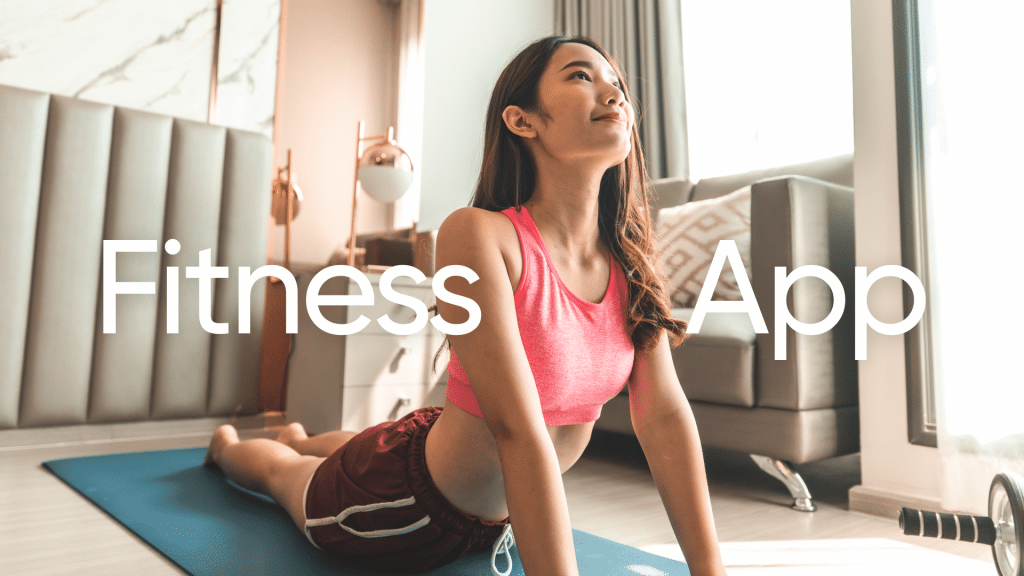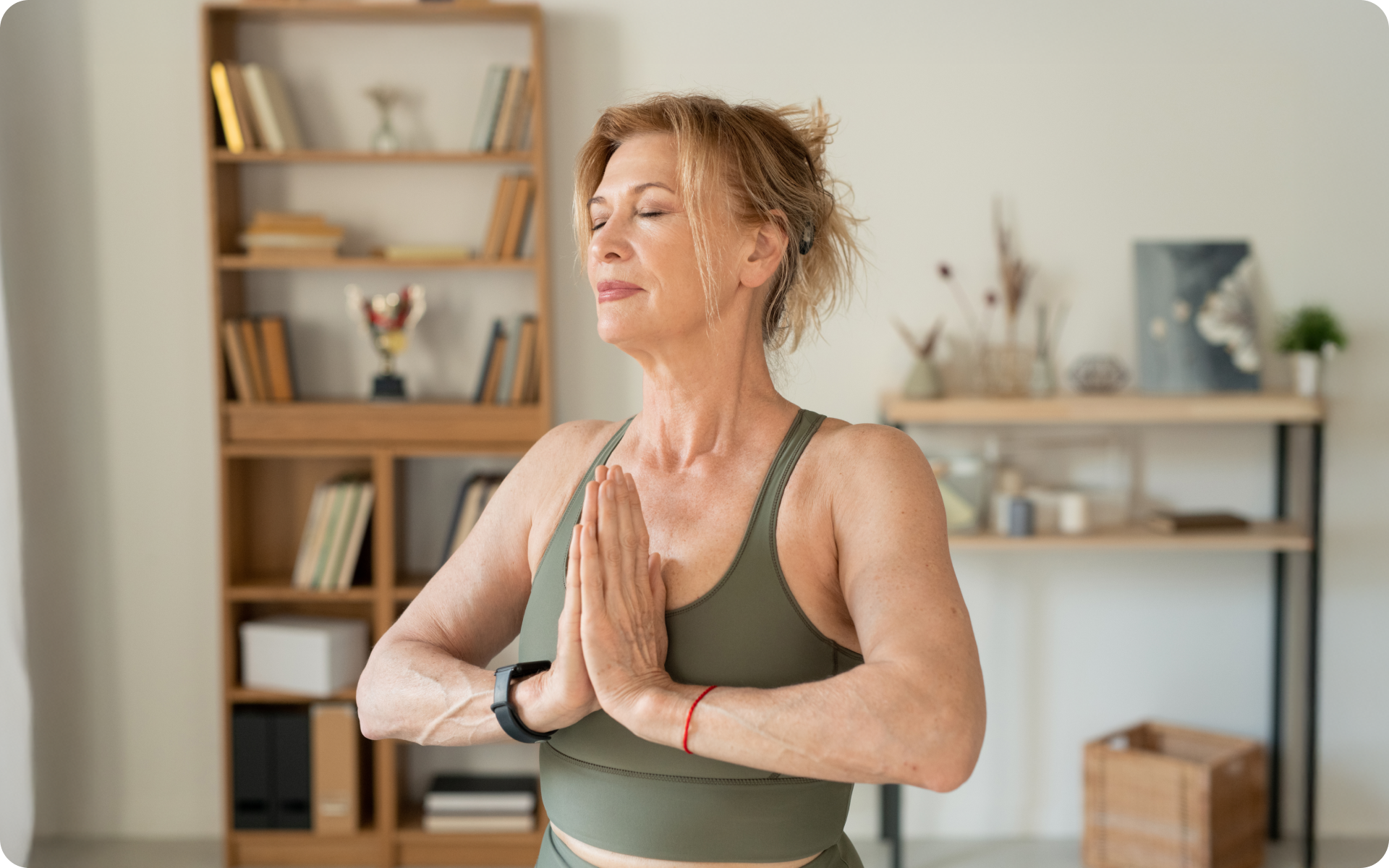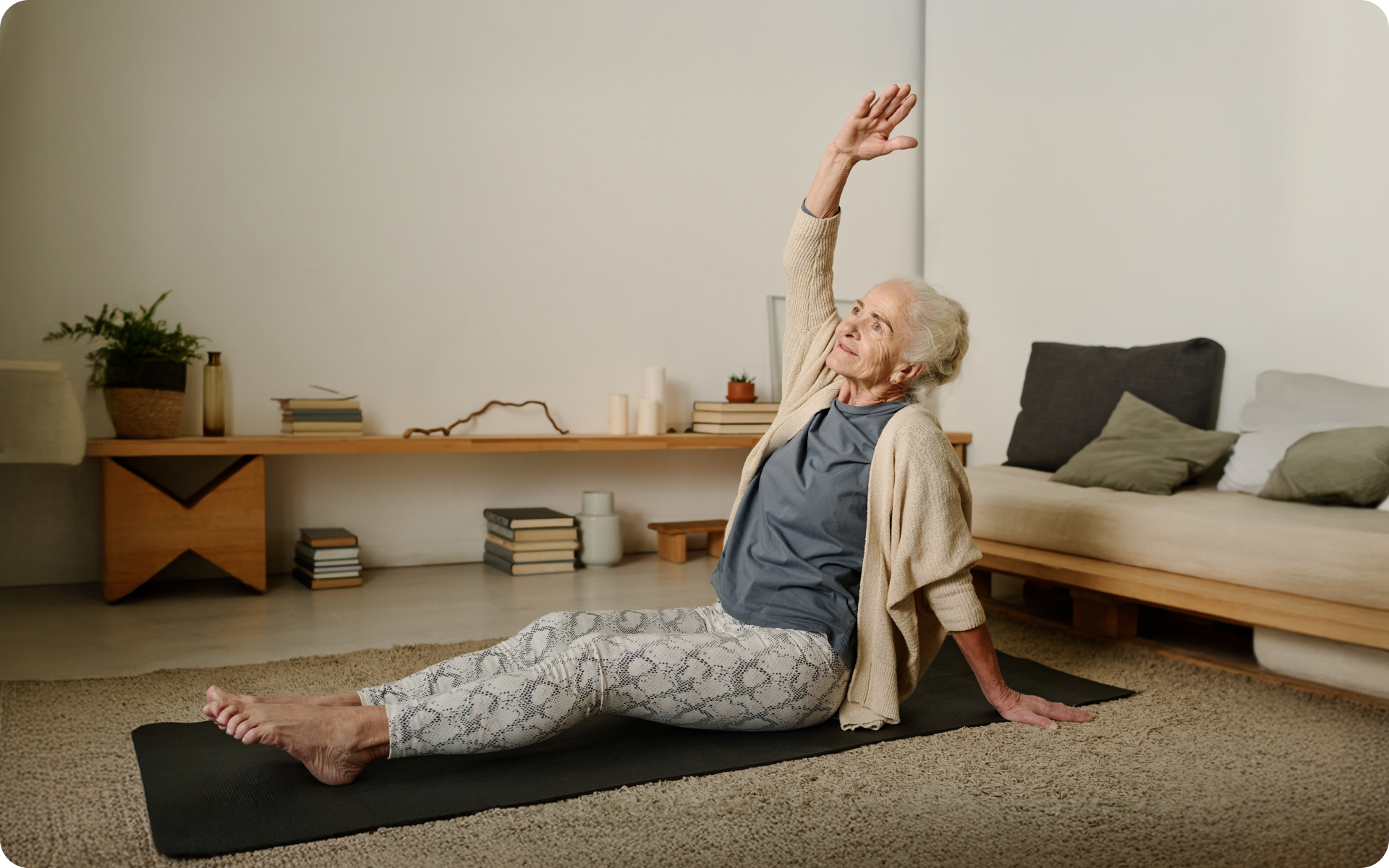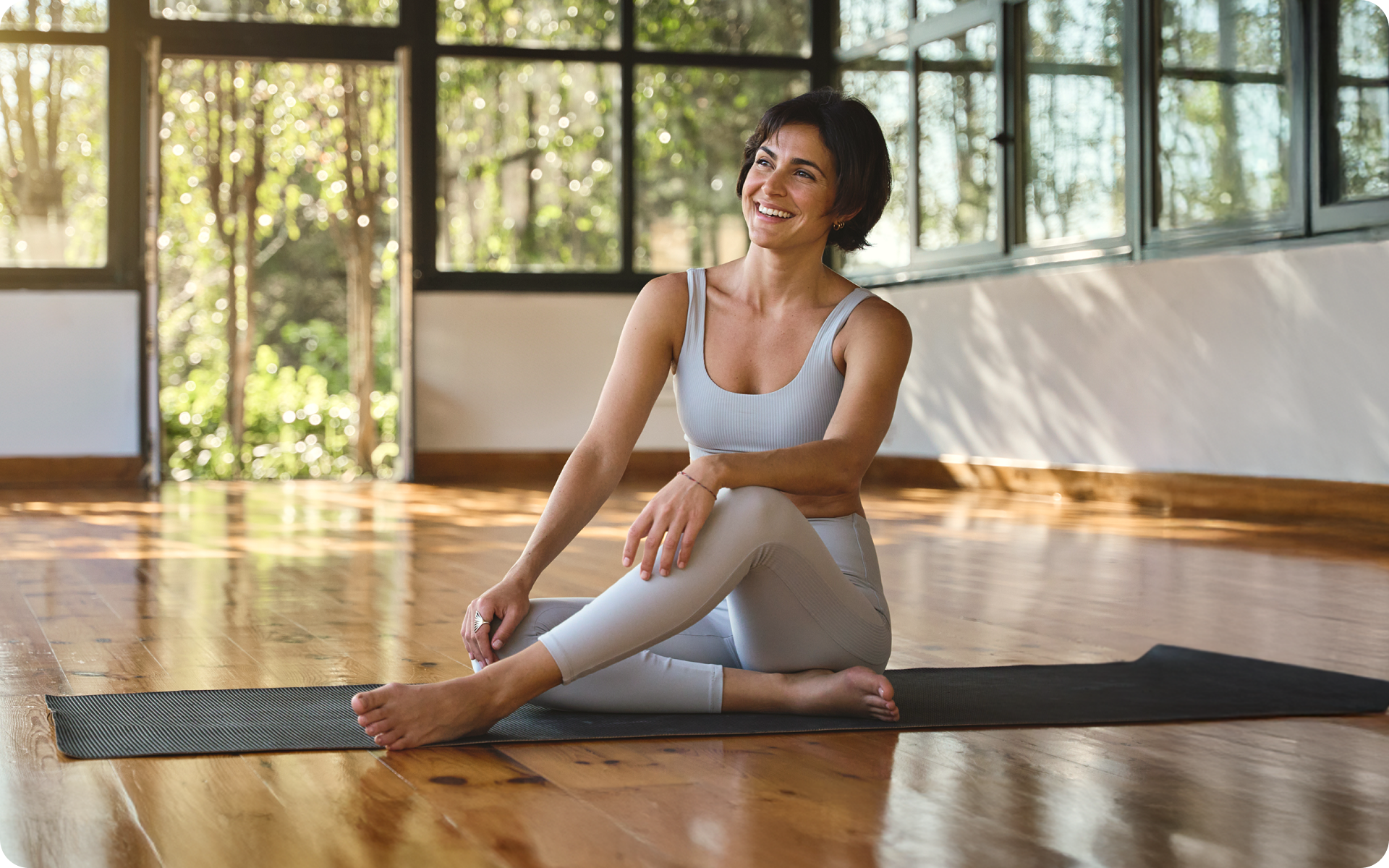Being a mind and body practice, yoga combines physical postures, meditation, relaxation, and breathing techniques. People engage in this activity for different reasons: to reduce stress, make their bodies more flexible, or simply open different perspectives towards life via transcendental movements. There are several types of yoga and many disciplines as well. However, today we are going to concentrate mainly on asanas. A logical question would be “What is an asana in yoga?”. The answer to it is simple: Asana is a physical practice of yoga positions. All such poses are built from the modern Hatha practice. Hatha yoga is a generic term for any type of yoga which concentrates on teaching physical poses. If you are a beginner, this type of yoga is vital in teaching you basic yoga poses. If you desire to unravel the main yoga asanas and their benefits for your physical and mental health, then stick with this article.
What Is An Asana In Vinyasa Yoga?
Asana is an essential part of vinyasa yoga. Before we jump into the practices, we need to discover what vinyasa yoga entails.
Vinyasa yoga means “flow” which means the smooth way in which poses come one after another. Being different than Hatha, which is more focused on one pose at a time with the rest in between, the vinyasa classes mix poses together and create a sequence. The sequences can be fixed or interchangeable. Yoga instructors arrange them in their own way. In vinyasa yoga, each pose is synchronized with a breath. With each breath, you move from one pose to another (5).
Therefore, a vinyasa is a sequence of poses – asanas. Asanas play a crucial role in vinyasa yoga since they are a cornerstone of the breathing sequence. In simple words, without asanas (positions), there won’t be any vinyasa.
Vinyasa yoga keeps you active and improves your health. Due to invigorating sequences, vinyasa yoga reduces the stiffness that comes with age and reduces the risks of high blood pressure.
In our life, we often deal with stress and depression. In this case, substituting cigarettes and alcohol with an active vinyasa sequence will be the right decision.
How Many Poses Are In Vinyasa?
There are three yoga positions in vinyasa which describe a series of three poses – plank, chaturanga, and upward-facing dog. You need to use your breath as you move to the next pose.
Plank
- Begin in a plank position. If the plank is too tough for you, you can always place your knees on the floor.
- Make sure your shoulders are above your wrists and your hips are in line with your shoulders.
Chaturanga
- Bend your elbows straight back.
- Hug your elbows into your side body
- Lower down as slowly as you can
- Stop when your shoulders are in line with your elbows
- Pause and hold in this position for a few seconds.
Upward Facing Dog
- Place your hands beside your lower ribs.
- Extend your legs and press them down on the floor.
- Press down with your hands and feet.
- Inhale and straighten your arms and lift your legs.
- Keep your arms perpendicular to the floor and draw your chest forward and up.
- Root down with your hands and draw your shoulders back.
- The curve of your neck should be a continuation of the curve of your mid and upper back.
- Hold for 5 breaths, then release.
Read More: Yoga Namaste – Evoke The Divine In You
What Is Asana?
Asana is a Sanskrit word that means “seat,” “posture,” or “place.” Yoga asanas are physical poses during a yoga practice. Each position has its own Sanskrit and English name. Most of the Sanskrit names for the poses end with “asana.”
The classic lotus pose, for instance, is called Padmasana. Interestingly though, a lot of the asana names have come from the shapes and movements of animals and elements of the natural world. Eka pada rajakapotasana is a pigeon pose, trikonasana is a triangle pose.
There are many yogasana types that altogether propose principles of alignment and muscular engagement.
These poses begin with simple twists up to advanced balancing poses. Asana yoga can be performed in a still and static position where people hold a breath for several seconds in one pose. Or it can be a part of a dynamic flowing movement, in other words, vinyasa that lasts for less than one inhale or exhale.
What Are The Five Benefits Of Asanas?
Yoga asanas do not only burn calories and tone muscles. It’s a total mind-body workout that encompasses strengthening and stretching with deep breathing and meditation or relaxation (5).
As well as a simple exercise, yoga is as effective or even better at improving health-related issues (4). There are more than five major asanas benefits but here we are going to focus on the most significant ones.
If you incorporate asana yoga into your routine, you will:
- End up with a stronger, more flexible, and balanced body. With the help of slow movements and deep breathing your blood flow increases and your muscles warm up. When you hold the pose, you boost your strength (1). Yes, it might be tough to hold asanas at the beginning but when you get the hang of them, every pose will bring pleasure to your body and mind.
- Get rid of that stress, or at least relieve it. Asana is vital to reducing stress, anxiety, and depression (3).
- Activate your brain. The research showed that due to yoga interventions, people increased their cognitive performance. Also, posture-based yoga, breathing, and meditation improve brain wave activity (2).
- Enhance your memory and regulate emotions. Studies have also shown the positive effect of yoga on the amygdala which is responsible for emotions regulation and encoding memories. The frontal cortex responsible for memory, attention, and other vital functions was also activated after yoga asanas (2).
- Improve heart health. With asana yoga, we reduce stress which contributes to a healthier heart. This is more due to controlling the pace of breathing which makes favorable changes in heart rate and stroke capacity.
BetterMe app will kick you out of the mental funk, shake off your extra weight, rid you off your energy-zapping habits, and help you sculpt the body of your dreams. Intrigued? Hurry up and change your life for the better!
What Are Some Yoga Poses For Two People?
Partner yoga is performing yoga poses with two people. Practicing yoga on your own is fun but when you engage in various yoga asanas with your friend or beloved person it becomes a real breathing journey with physical moves. It can strengthen your relationship both on and off the mat while improving balance, flexibility, and posture.
As well as regular asana yoga, two-people yoga poses bring essential benefits which include mental and physical perks, such as reduced stress, increased muscle strength, and improved breathing.
If you want to experience the benefits of yoga with a partner you should consider trying yoga poses for two people. Make sure both of you stretch before asanas and practice proper communication with your partner before and during the process to ensure you both are comfortable and safe.
Here are the best five yoga poses for couples. Get on the mat and improve your health with the person you truly care about.
-
Partner Boat Pose
A Partner Boat pose is beneficial for stretching the core and hamstrings. This asana is better for advanced yogis since it requires a lot of flexibility in the legs.
In order to perform Boat Pose with a partner, face each other in a seated position. Raise your legs and create an inverted V shape. Grab each other’s hands and lean into the stretch. You can modify the pose and make it more beginner-friendly by folding the knees.
-
Seated Forward Bend
Seated Forward Bend is an excellent stretch for beginners. This yoga pose targets the hamstrings, calves, and back.
You might intensify the stretch when performing this pose with a partner. To execute the pose, partners need to face each other while seated. After that, with straightened legs they press their feet flat together. Partners then grab each other’s arms, and alternate leaning forward to deepen the stretch in the hamstrings.
It is possible to modify the pose and make it more challenging by spreading the legs to create a diamond shape between the two partners. This advanced option will stretch the inner thigh.
-
Standing Partner Backbend
Standing Backbend is an activity that perfectly works up a full backbend. This couple’s pose stretches out the back and opens up the chest. People also call it a heart-opening pose.
To perform this asana, two partners need to face each other and lock onto each other’s arms. Then, place the head back so the chin is pointed toward the sky.
-
Double Tree Pose
The double Tree pose is a modified asana from an individual variation of the Tree Pose. This activity is also vital for beginners who have not experienced yoga classes before. It makes this pose a great starter for people new to the yoga practice.
In this standing pose, each partner balances on one leg. The next thing they do is hold onto each other with one or both arms, which contributes to improved stability. The couple should hold the pose for several seconds to find equilibrium together.
Read More: The Yoga Lifestyle: How To Find Balance In Your Life
-
Double Standing Forward Fold
Double Standing Forward Field is one of those poses that benefit hamstrings by stretching them. When you perform the Standing Forward Bend this pose solo, you stretch the legs by bringing the head to the knees.
In the case of two people, this pose should start with them facing away from the other. They should reach their arms back to hold onto each other. This cultivates a much deeper stretch as the partners work together to improve their flexibility.
What Are The Types Of Yoga Asanas?
You are aware now that asanas are yoga poses supported by the ground, people, or objects. They can be structured into different categories based on their body position. Yoga teachers use the following types of asanas in their Hatha classes.
1. Standing Poses
The standing poses are regarded to be the foundation of any hatha yoga class. They help yogis build strength and flexibility throughout the entire body. Standing poses activate the muscles, therefore, warming up the body. When people stand during this type of asana yoga they must pay attention to the placement of their feet, hips, knees, spine, and head. In case of disregard, people can injure themselves.
2. Seated Poses
Seated asanas are the most common yogasana types that are beginner-friendly. Seated yoga postures focus on stretching rather than on strength. You create a stable position and relax while sitting on the floor. Another advantage of seated asana positions is that they are adaptive to any level of strength and flexibility. They build awareness of the right breath and how it affects the body. In addition, seated poses improve posture by engaging the core muscles and allowing us to sit upright.
3. Twisting Poses
Twisting asanas are often used to increase flexibility in the entire body and release tension in the spine. Twists are excellent postures for body rebalance after a series of backbends or forward bends. In addition, they strengthen the muscles that protect your back. Twisting poses can help yoga practitioners open their hips, strengthen the abdominal muscles and improve digestion.
4. Core Strengthening Poses
Core-strengthening yoga poses improve your overall fitness level and help you avoid injury. They strengthen the abs, which are vital for body stabilization, allowing us to stand or sit. Such poses also reap strength in the muscles that stabilize the hips and pelvis. This can prevent lower back pain and injuries. Besides building strength, these poses enhance flexibility by lengthening the hamstrings and opening up the hips.
5. Balancing Poses
Balancing asana poses are usually performed by standing on one foot. Therefore, they require more stability and core strength than other types of yogasana poses. Balancing poses help you build strength, balance, and improve concentration. They also make the legs, arms, neck, and back stronger. You will improve your posture with balancing poses as well which is great for falls and injury prevention.
Lean and toned up body isn’t just a far-fetched fantasy. Check out the BetterMe app and watch it propel your weight loss journey into high gear!
6. Prone Poses
Prone asanas postures are quite easy positions that require your belly or torso to face the floor. A lot of prone yoga poses invigorate the whole body and strengthen the heart, lungs, and diaphragm. Prone asana poses also improve digestion by stimulating the digestive organs.
7. Supine Poses
You should perform the supine poses asana lying down on your back. These poses are easier compared to standing poses because they require less balance and coordination. Supine positions promote flexibility and release stress. Since they are so calming and nurturing these poses are usually performed at the end of the yoga class. Supine poses relax the body and mind, and might even help people who suffer from insomnia or anxiety.
The Bottom Line
What is an Asana in yoga? – the common question many yogis ask when they start off with the yoga journey. In simple words, yoga asanas are physical poses during a yoga practice.
Asana poses are used in various types of yogas including vinyasa – the activity which is not focused on one move during a few seconds but rather on the sequence of different moves which change relatively fast.
Asana poses help reduce stress and anxiety, activate brain work, build stronger muscles, improve posture, and enhance flexibility.
There are a lot of variations of yoga asanas for two people that positively affect overall health.
Among the most common yogasana types are standing, seated, twisting, balancing, prone, and supine poses.
DISCLAIMER:
This article is intended for general informational purposes only and does not serve to address individual circumstances. It is not a substitute for professional advice or help and should not be relied on for making any kind of decision-making. Any action taken as a direct or indirect result of the information in this article is entirely at your own risk and is your sole responsibility.
BetterMe, its content staff, and its medical advisors accept no responsibility for inaccuracies, errors, misstatements, inconsistencies, or omissions and specifically disclaim any liability, loss or risk, personal, professional or otherwise, which may be incurred as a consequence, directly or indirectly, of the use and/or application of any content.
You should always seek the advice of your physician or other qualified health provider with any questions you may have regarding a medical condition or your specific situation. Never disregard professional medical advice or delay seeking it because of BetterMe content. If you suspect or think you may have a medical emergency, call your doctor.
SOURCES:
- 9 Benefits of Yoga (n.d., hopkinsmedicine.org)
- Effects of yoga on brain waves and structural activation: A review (2015, ncbi.nlm.nih.gov)
- The Effect of Yoga on Stress, Anxiety, and Depression in Women (2018, ncbi.nlm.nih.gov)
- The health benefits of yoga and exercise: a review of comparison studies (2010, ncbi.nlm.nih.gov)
- Yoga (2021, webmd.com)













